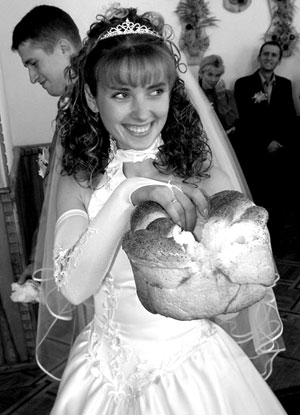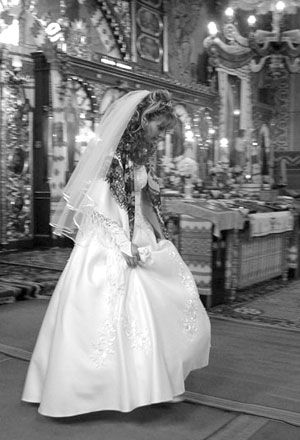- About Ukraine
- Hutsuliya
- Rest and Tourism
- Photograph Album
- Library
- Hutsul Legends
- Hutsul Customs and Traditions
- The Carpathian Pastoral
- Hutsul’s Hospitality and Politeness
- Hutsul Wedding
- The Wedding Day In Kosiv
- Hutsul Holidays and Traditions
- Hutsul Folk Art
- Feed
- Store
Weddings in Ukraine were traditionally celebrated in the autumn when peasants gathered rich harvests of vegetables and fruits. From morning till night, the knocking of hammers was heard throughout the villages: carpenters were making long tables and benches. A mood of hilarity pervaded the atmosphere. Young and old waited impatiently for the day of festivities to come because no folk ritual could be compared to the unique ceremony of a wedding. Especially impatient were the bridegroom and his bride.
According to tradition, before the wedding, a girl had to embroider a shirt for the young man she loved. Her fiancee would invite two respectable village men for matchmaking and the three of them would come to the girl’s parents with bread and salt.
A pumpkin on a plate handed to the matchmakers meant a girl’s refusal. If she agreed to marry, she had to go over to a pitch (stove) and begin to peck at it. Then she would present the matchmakers with rushnyks (towels) who tied them across their shoulders. The bride-to-be tucked a kerchief behind the belt of her future husband.
On the eve of the wedding, which usually took place on Saturday, women of the village gathered in the houses of the groom and the bride to bake korovais (wedding bread), which were a symbol of the young couple’s well being.

Korovais were put into the oven with a small candle, which was placed in the middle cone. A bride and her best bridesmaid walked from house to house — jnviting guests to her wedding.
The bride invited her girl friends for a party on Friday. The girls sang melancholic songs of how a young bride was parting with her girlhood and freedom, and of her new life with the family of her groom. Often a young wife performed the greater part of heavy household work. At the party the girls exchanged gifts. The groom was presented with a shirt sewn and embroidered by his bride. He had to wear this shirt on the day of their wedding.
On Saturday morning, the younger brother of the bride unbraided her hair to the singing of a girls’ choir.
The bridesmaids spread water over her hair. After this, the bride got up from her chair and the girls rushed to take her seat. According to popular belief, the girl who was the quickest to occupy the chair would marry soon. In the meantime, the groom also got ready to meet his future wife. At last, he and his best man went to the house of the bride. There her parents blessed the young couple and the best man gave a kerchief to the groom and the bride. Holding it, they walked out of the house and the bridal procession went to the church.

After church the groom and the bride returned to their paternal houses or went to the house of the bride. Her parents who greeted them with bread and salt met them. They offered the groom a goblet of horilka, which he poured over his shoulder.
The guests followed the groom and the bride. They sat at the table, ate, and sang. The door was left open for everyone who wanted to come in. Every village had musicians who played at weddings.
The obligatory musical instruments were a violin, a dulcimer, and a tambourine. The most popular wedding dances were hopak, hutsulka, polka, waltz and dribushechka. The round dance was the most ancient one. It was performed around a wedding procession, a table, or a house.
After the dances, the bridegroom went home alone, and his bride stayed in her parents’ house where festivities continued. In the groom’s house, guests were invited to the table and rituals were performed. For example, his mother scattered sweets, and nuts around. The choir sang songs, which contained magic words wishing a happy marriage to the young couple.
In the evening a wedding procession that consisted of the maid of honor, best man and bridesmaids, matchmakers, and musicians made for the house of the bride. Along their way they sang songs. Near the house of the bride they had to overcome different obstacles put before the groom and his suite by the young people on the bride’s side.
At last the gate was opened and the procession was allowed to enter the yard and then the house. The young groom redeemed his bride and her relatives.
After redeeming his bride, the groom sat down beside her and the covering of the bride was performed.
The two matchmakers would hold an open kerchief over the bride’s head.
At the wedding party, the bride had no right to smile but had to pretend that she was sad. On the other hand it seemed there was no end to the jokes and humorous stories told by village elders and matchmakers. One of the village elders was the master of the ceremony.
The dividing of the wedding loaf was especially solemn. First a village elder offered the groom and the bride the loaf top cut into halves and then gave the rest of the loaf to the guests. All those present sat down to supper. After the supper, the boyars began to prepare the bride for the way to her bridegroom’s house. They tried to filch as many things from the yard as possible with them, but the young men on the bride’s side hindered them from doing so. At last, the bride said goodbye to her parents who wished the young couple a safe way home.
The wedding arrived at the groom’s house early in the morning.
The marriage ceremony differed greatly according to the locality in which it was celebrated while such accompanying festivities as matchmaking; bread baking and the holding of the girls’ party are mainly the same in all districts of Hutsulshchyna.
Ensembles performed wedding rituals. Their bright costumes, melodic language, music and performing skills were so impressive that, you could be carried away to Hutsulshchyna and breathe the fragrant scent of pine forests.
Welcome to Our Hutsul Land!

